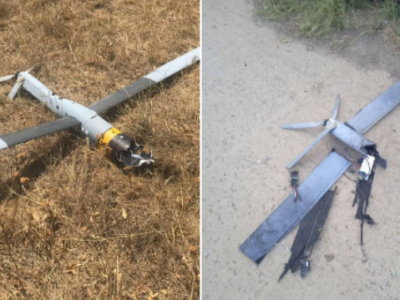Two days ago was the one year anniversary of the Great Patriotic People Of Gaza’s Brave Attack On Yahweh.

Israeli detransitioned lesbians hit hardest. Never forget the pile of shoes breast binders.

A few weeks ago I wrote an article on the Abrams failure in Ukraine, along with the F-35’s no-show and the US Military’s new, spectacularly bad main rifle. I briefly mentioned the new USMC mission of sea denial. In short, their plan is to capture a large number of very small islands. They then install a skeleton crew of marines equipped with a few dozen dispersed anti-ship missiles to attack surface ships within a certain radius around the island. Perhaps combined with some very small patrol boats or aircraft to spot targets.
Essentially, it’s the USMC version of what the Houthis have been doing to Israel, which has shut down the majority of shipping in the Red Sea, and even bankrupted Israel’s only Red Sea port. Since it’s also almost the one year anniversary of the Houthi’s attacks on shipping, which started on October 19th, 2023, I thought I’d take a closer look at that.

But why start with reasoned analysis, when we can laugh at the zionist NPCs on (P)reddit?

My hebrew trans vagina is positively trembling with rage at these NATZEES throwing up Hitler salutes. These bigots must be genocided!

This graphic is unintentionally awesome.
Those Houthi scum have pirated an Israeli ship. That might seem like a victory, but ackshually it’s the Houthis who are about to be ritualistically humiliated by the US Navy that keeps having its own boats run into each other, and has obese Latinx captains installing satellite TV dishes on their boats so they can watch Mexican soap operas.
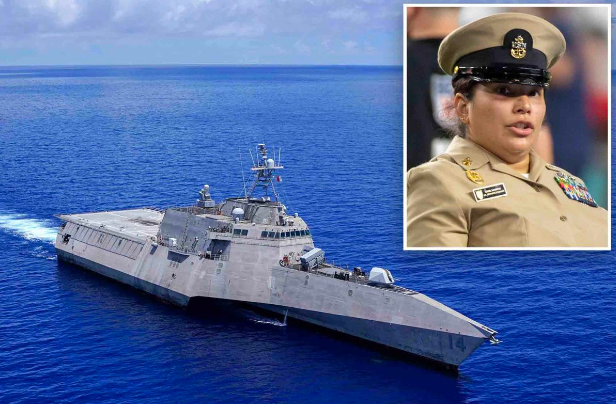
By the way, New Zealand just had one of their six surface ships sink because a Lesbian drove it into a reef.
New Zealand has lost its first warship since the chaos of World War II after a celebrated LGBT commander was assigned to the helm.
The vessel was the first command of celebrated LGBT naval officer Yvonne Gray.
According to the New Zealand Defense Force, Gray, a lesbian officer who originally worked in the United Kingdom’s Royal Navy, took command of the Manawanui on December 9, 2022.
Gray then commented on how she wanted to “drive” a ship.
“With Manawanui, it’s not just about the command,” Gray said in 2022. “This is an opportunity to take a ship still in its infancy and further the capability of that ship, and influence and help those who carry our Navy into the future.”
The New Zealand Navy celebrated Gray in a 2023 “Women Commanding the Navy” article.
The loss of even a single ship is staggering for New Zealand’s navy, which has only five workable ships after the loss of the Manawanui.
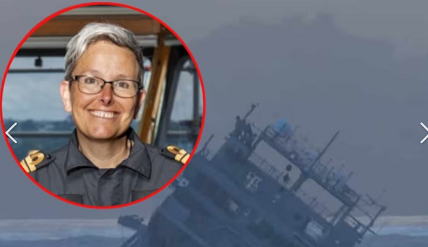
Okay, that might have been a little bit embarrassing, but ISRAEL IS OUR GREATEST ALLY DAMMIT.

Israel doesn’t even know the people who just bankrupted their only Red Sea port. They don’t even know them. They are not aware of this geostrategically important fact, possibly because the Mossad is too busy rigging up tamagotchi pet machines with explosives in the hopes that maybe a terrorist is into that kind of thing.

The Houthis aren’t even native English speakers. They make small mistakes in their translations. FUCKING OWNED.

It’s finally habbening. The Houthis have entered the “Find Out” stage, nine months ago since time of writing. At this point, they must be totally destroyed.

Alternatively, nothing could have happened to them, and they could continue their attacks in the Red Sea and Gulf of Aden to their hearts content, shutting down the majority of shipping through The Red Sea. How could this happen? After all, “the US prefers to underhype its technological advantage.”

This might be the most reddit comment chain on the internet.
There is something beautiful about seeing your enemies getting really excited about something, and then showing up a few months later to collect the copium. (P)redditors are the absolute scum of the internet. They are what you get when you couple obedient personality disorder with the anonymity of the internet. Their brains are purely the result of the propaganda that they’ve been given, and while the WMD Liars tend to be more measured, the general zionist media has suffered through the same Houthi cockblocking. Let’s see what they’ve been saying over the past twelve months.
Air Space And Forces (December 12th, 2023):
In particular, the Houthis have launched numerous cruise missile, ballistic missile, and drone attacks over the Red Sea in recent months; damaged ships; seized a vessel; and shot down an American MQ-9 drone.
“The actions that we’ve seen from these Houthi forces are destabilizing,” [Pentagon Press Secretary Air Force Maj. Gen. Patrick S. Ryder] said. “They’re dangerous and clearly a flagrant violation of international law. This is an international problem that requires an international solution.”
“You could take action against coastal radars, coastal gun systems, missile systems, those kinds of sites,” said Votel. “There are very clear military targets.”
“It can degrade their capability in the near term, and at the same time, send a very clear message,” he said.
One month into the Houthi’s plan for Total Brown Fascism, and Uncle CSAM had already identified the targets. Let’s check in with USA Today ten days later to see how that went.
USA Today (December 22nd, 2023):
The U.S. and nine other nations will send naval warships to the southern Red Sea to repel attacks on merchant carriers by Houthi rebels in Yemen, U.S. defense officials said Monday.
Operation Prosperity Guardian, announced by Defense Secretary Lloyd Austin, is an effort by the multinational coalition to blunt a rise in missile and drone attacks on commercial traffic near the Bab el-Mandeb strait. The strait is a chokepoint between the Red Sea and the Gulf of Aden.
A multinational coalition of our best and brightest are on the case!

A coalition of ZOG is inbound. The attackers will be repelled. It’s just that simple.
The Giardian (January 10th, 2024):
A week ago, the US, the UK and 10 other mostly western nations told Yemen’s Houthi rebels that they would “bear the consequences” if they launched further attacks on merchant shipping in the southern Red Sea. For a brief period – six days – the Houthis paused, before at 9.15pm on Tuesday launching their most sophisticated attack yet.
Eighteen drones, described by the British as of Iranian design, and three missiles appear to have targeted a fleet of warships in and around the 18-mile-wide Bab el-Mandab strait, where the Red Sea comes closest to Houthi-controlled Yemen. Though they were all shot down, the brazen nature of the attack was not lost on western politicians.
Prior to Tuesday night, 61 drones had been fired in 25 attacks. But in the early evening, a group of 18, probably the relatively inexpensive delta-wing Shahed 136, appear to have been aimed at the warships directly. Seven were shot down by HMS Diamond, which Shapps told reporters “potentially was targeted”.
Remember the Shahed 136 from the previous article? The Russians use them almost entirely as cruise missiles, but there is a remote control version with a camera attached. It’s possible that the Houthis are using that version. It’s also possible that the ship was moored, and they just flew them to a certain GPS coordinates, or they mistook another cheap piston prop aircraft for the 136. Either way, the point is that this was an incredibly inexpensive attack.
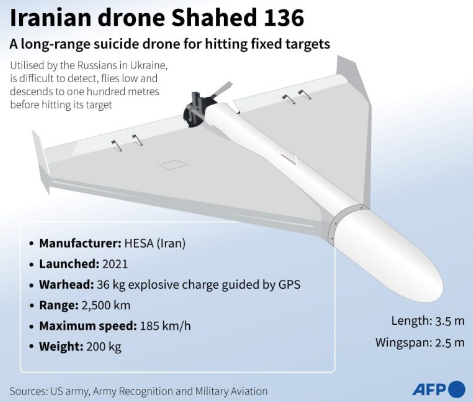
I bring up the expense, because we are trying to impose costs on our opponents by launching these things. If we were to launch a $20k piston prop cruise missile/loitering munition and hit nothing more than a cache where they were keeping these $2 million Aster anti-air missiles, damaging only one of them, that would be a tremendous accomplishment. When they launch one of these missiles to intercept our missile, they’ve effectively done this for us.
Attacking in a swarm is a tactic taken from Ukraine, where several Shahed drones are deployed in an effort to overwhelm local air defences – and even when they are all stopped, it imposes costs on the defenders.
A Shahed 136 costs $20,000 (£16,000) to make, while missiles for HMS Diamond’s Sea Viper defence system cost £1m to £2m a time, although the costs of losing a warship – or human lives – is far greater.
All warships have extremely limited stockpiles of anti-air defenses. It’s not possible to put hundreds of anti-air missiles on a ship, or even a few dozen. Even if they get a 100% hit rate per missile, we can overwhelm them with relatively low numbers, although the Houthis are not exactly flush with material. Makes me hope that the rumours of Russia supplying them with weapons are true.
Anyway, I’m sure that the Houthis will shortly be dealt with. The US and British Navy have their finest lesbians in the area.
A Houthi anti-ship ballistic missile struck a US-owned and operated cargo ship on Monday, US Central Command said in a statement.
The attack against the Gibraltar Eagle appears to be the first time the Houthis have successfully struck a US-owned or operated ship, raising the stakes in the Red Sea after the US vowed that further Houthi launches would be met with a response.
It came just days after a US-led coalition carried out strikes against the Iranian-backed rebel group in Yemen and warned more strikes were possible if the Houthi attacks continue.
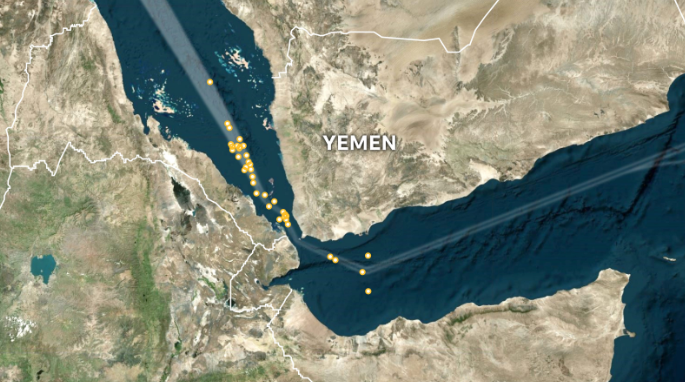
Partial map of the attacks from late 2023.
We’re almost a month past the point where the US Navy was supposed to be ritualistically humiliating the Houthi Natzees. I guess it must take a while for the sensor fusing networked force multipliers to come online and use their situational awareness to bring sixth generation land sea weapons with distributed lethality to bare on the tanned nazis. Two more weeks until the Houthi menace is jewhaded off the face of the earth.
The United States has named the ongoing operation to target Houthi assets in Yemen “Operation Poseidon Archer,” according to two US officials.
The named operation suggests a more organized, formal and potentially long-term approach to the operations in Yemen, where the US has been hitting Houthi infrastructure as the Iran-backed rebel group has vowed to keep targeting commercial vessels in the Red Sea and the Gulf of Aden.
Finally we’re getting Operation Poseidon Archer on the road. I was wondering why the Houthis were still attacking ships, but if the geniuses in high command were waiting to come up with a super awesome operation name first, I totally understand.
War On The Rocks (April 23rd, 2024):
The United States is engaged in its first major naval combat since World War II, according to the commander overseeing U.S. naval forces in the Middle East. But instead of pitting the world’s major powers against each other, this battle is between a superpower and an isolated armed group controlling one of the poorest, most resource-deprived areas on Earth.
Houthi attacks on maritime shipping in the Red Sea are undermining freedom of navigation as an international norm, jeopardizing a principle that has underpinned the international system and global economy for decades. The fact that the Houthi attacks have faded from the news cycle even while attacks persist and major shippers continue to boycott the Red Sea is evidence that a “new normal” has set in, where freedom of navigation is no longer assumed.
This threat is unlikely to go away soon. The Houthis have many reasons to continue attacks in the Red Sea and potentially beyond even after a ceasefire takes hold in Gaza, and the international response to date has proven insufficient to deter them. A variety of non-state, rogue state, and other revisionist actors are also taking note of how effectively Houthi attacks have disrupted commerce.
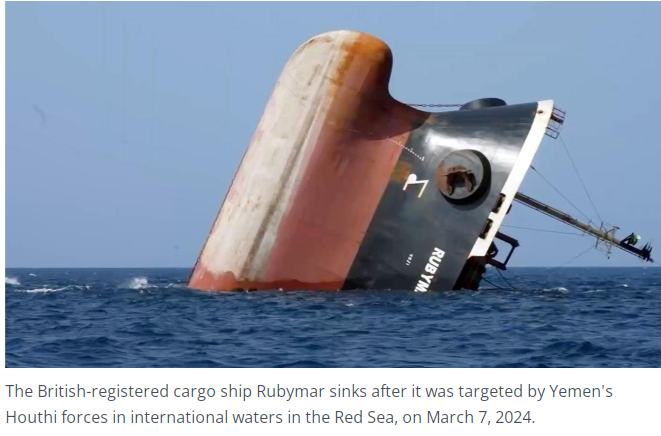 What are you talking about? Lloyd Austin and Anthony Blinken promised me that these anti-semitic cockroaches would soon be stomped on. Four months later you’re telling me that there is no end in sight to the Akbar Fascists?
What are you talking about? Lloyd Austin and Anthony Blinken promised me that these anti-semitic cockroaches would soon be stomped on. Four months later you’re telling me that there is no end in sight to the Akbar Fascists?
DUBAI, United Arab Emirates (AP) — Yemen’s Houthi rebels launched an explosive-loaded drone that crashed into one ship Tuesday in the Red Sea and a missile that exploded against another.
Two more weeks until the Houthis find out. Two more weeks!

Houthi “drone” boats are essentially jet skis that are laden with explosives. They appear to be effective, although I’m not sure if the Houthis find them to have some large advantage, perhaps in hitting a ship at the waterline, or if they just don’t have a lot of missiles and are making do with what’s available. Maybe a bit of both.
The first attack took place some 110 kilometers (70 miles) off the port city of Hodeida and targeted the Panama-flagged oil tanker Cordelia Moon, the multinational Joint Maritime Information Center said. A captain on a ship saw four “splashes” near the vessel, the center overseen by the U.S. Navy said. That likely would have been missiles launched at the vessel that missed.
The drone boat later damaged the Cordelia Moon, which sustained a puncture to one of its ballast tanks in the attack. Those tanks control a ship’s buoyancy. Houthi strikes in the past have targeted ships at their waterline to disable the vessels.
The Cordelia Moon, an English tanker, was successfully attacked by the Houthis about a week ago.

I can’t find conclusive evidence that the ship sank. Only that it “sustained a puncture to one of its ballast tanks in the attack.” It may have sank later.
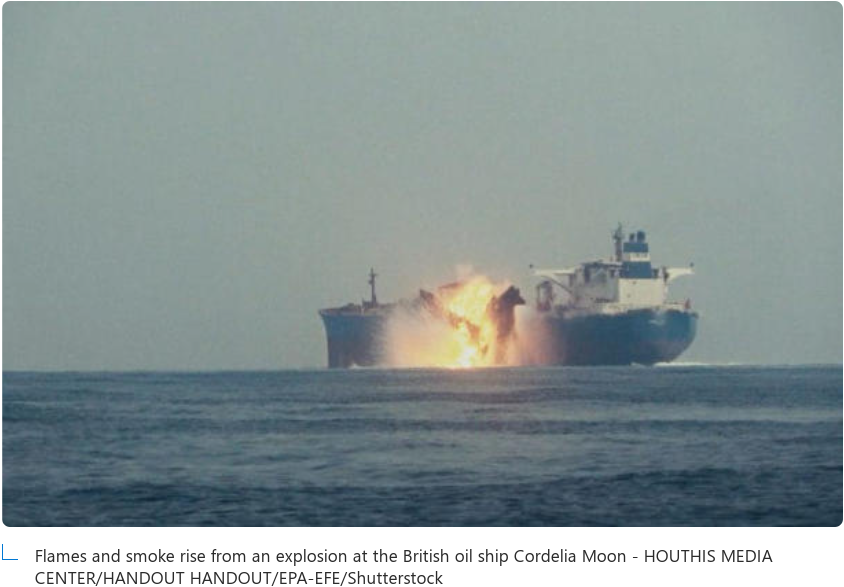
Here you can see the attack from the perspective of the Cordelia Moon. The remote control boat hits just before the two minute mark.
Whatever the result of this particular attack, it’s not hard to see why shipping is down so much in the Red Sea.
Who wants to deal with these guys boarding your tanker and blowing it up?

Stripes (September 12th, 2024):
The Houthis have cut Suez Canal traffic by more than half, starving Egypt of toll revenues. They have bankrupted the Israeli port of Eilat in the Gulf of Aqaba. Nearly a year on, the group appears less deterred than emboldened: It recently crippled an oil tanker, threatening a spill with catastrophic environmental consequences. A waterway that carried 10% to 15% of global trade has become a killing zone.
This Port of Eilat is Israel’s third largest port by tonnes of cargo imported per year, and their only port on the Red Sea.
The “Israeli” port of Eilat officially declared bankruptcy due to a significant drop in commercial activities and revenues, largely attributed to the naval blockade imposed by Yemen’s Houthis on “Israeli”-linked cargo ships since last November, Middle East Monitor reported.
He highlighted the severity of the crisis, noting that only one ship has docked at the port in recent months. “The Yemenis have effectively shut off access to the port,” he added.
Golber revealed that operations at the port have plummeted by 85 percent since the Houthis began targeting “Israeli”-linked vessels. He warned that if the situation does not improve, temporary layoffs may be necessary.
Al Jazeera gives a decent overview of the naval blockade.
Six weeks after Hamas launched the deadliest attack on Israel in the country’s history last October, the Palestinian group’s Houthi allies in Yemen seized control of a British-owned cargo ship in the Red Sea.
The Houthis’ audacious hijacking of the Galaxy Leader would mark the start of a sustained campaign of missile and drone attacks against commercial shipping in one of the world’s most important trade routes.
The capture of The Galaxy Leader is a fun little mini-tale in and of itself. It starts with the Houthis flying onto it in a helicopter.
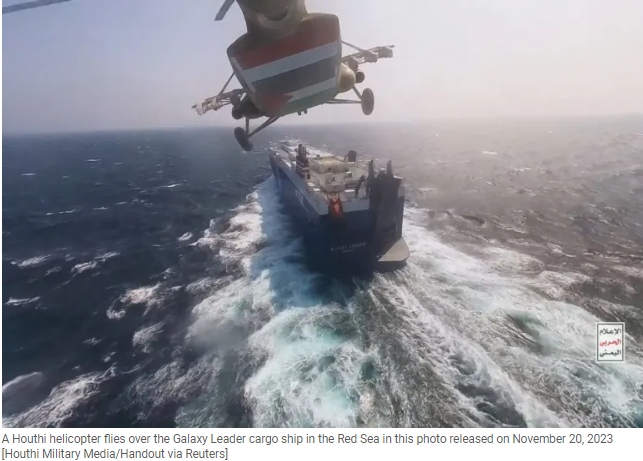
Immediately followed by an impotent demand by the US Military to hand over the boat.
The United States on Monday denounced the seizure of a cargo ship in the Red Sea by Yemen’s Iran-backed Houthi movement as a violation of international law and demanded the immediate release of the vessel and its crew.
“The Houthi seizure of the motor vessel Galaxy Leader in the Red Sea is a flagrant violation of international law,” State Department spokesperson Matthew Miller told a briefing. “We demand the immediate release of the ship and its crew and we will consult with our allies and UN partners as to appropriate next steps.”
The British-owned, Japanese-operated commercial ship was “illegally boarded by military personnel via a helicopter” on Sunday and is now at the Hodeidah port in Yemen, the vessel’s owner said on Monday.
Yet, four months later the ship remained with the Houthis.
CNN:
Hope is fading for the imminent return of the international crew of the cargo ship hijacked by the Houthis in November, with a senior Filipino diplomat saying he does not expect a release until the war in Gaza is over, while the Houthis say the fate of the sailors is now in Hamas’ hands.
A Houthi-owned helicopter hijacked the Galaxy Leader cargo ship on November 19 in the Red Sea, as rebel gunmen laid siege to the vessel and took the ship’s crew of 17 Filipinos, two Bulgarians, three Ukrainians, two Mexicans and a Romanian hostage.
It’s now been more than 116 days since the hijacking, and according to a senior Filipino government official, there is no indication that the Houthis are open to releasing them until the hostilities end.
As of September 26th, the ship and crew remain controlled by the Houthis.
AP News (September 26th, 2024):
CAIRO (AP) — A team of the international Red Cross visited a 25-member crew on board of the Galaxy Leader vessel, which was hijacked last year by the Iran-backed Houthi rebels and is docked in the port city of Hodeidah— a Houthi stronghold.
Nasser El-Dien Aamer, general director of Saba News Agency who accompanied the ICRC during their visit, told Houthi-controlled al-Masirah TV that the fate of the crew members depends on negotiations with Hamas given that it’s an Israeli ship.
They’ve got your ship, bro. Maybe you should demand it back harder.

Back to the Al Jazeera article.
As the war in Gaza approaches the one-year mark on October 7, Houthi attacks are still disrupting commercial shipping, exposing the vulnerability of the supply chains that form the backbone of international trade.
While a United States-led international force has been able to thwart many attacks, commercial ships continue to be targeted and operators remain hesitant to use the waterway, raising the likelihood that trade will continue to suffer as long as conflict persists in the Middle East.
The Houthis, which like Hamas are backed by Iran, carried out 130 attacks in the Red Sea between the start of the war and September 20, according to the nonprofit, Armed Conflict Location and Event Data (ACLED).
The Yemeni group has said that it considers any ship linked to Israel or its allies a target, casting its attacks as a show of support for Palestinians facing Israeli bombardment in Gaza.
As of mid-September, average daily transits through the Suez Canal stood at 29, compared with about 80 last October, according to PortWatch, a database run by the IMF in collaboration with Oxford University.
Over the same period, average daily trade volume dropped from about 4.89 million metric tonnes to 1.36 million metric tonnes, according to PortWatch.
The Houthi naval blockade of Israel has resulted in a 60-65% reduction in shipping through the Red Sea. That’s even more impressive than it initially appears, since the Houthis are selective in their targeting, much to the chagrin of many a whiny zionist.
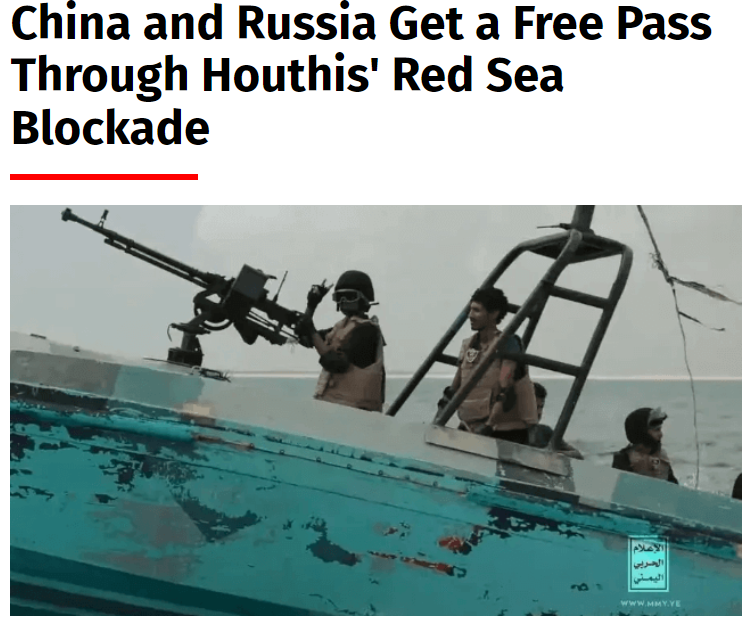
We know due to the bankruptcy of the Port of Eilat how much shipping has made its way into Israel, and the answer is almost none.
For shipping lines, rerouting trade around the Cape of Good Hope has increased transit times by 10-14 days and pushed up freight rates as much as threefold at certain periods during the past year.
“This rerouting incurs approximately $1m in additional fuel costs per trip,” George said.
Ultimately, the impact on Israel will be somewhat minor, assuming their much larger Mediterranean ports can pick up the slack. Those ports could potentially be hit by Iranian ballistic missiles, but it remains to be seen if they can be shut down indefinitely, or if Iran will even try. Their leadership is politically timid, and if Israel doesn’t respond to their October 1st attack, I doubt they’ll escalate, even though there are a lot of things that they might be able to do.

I’m a bit skeptical of any consistent long range interdiction plan.
How are the Houthis having so much success?
Hansen said that the US and United Kingdom air strikes on Houthi targets in Yemen were more “symbolic than having real value” and governments would be better off boosting their capabilities to intercept missiles and drones in the waterway.
“It did not scare the Houthis,” he said.
The Houthis, he said, “were able to hide and secure much of the equipment needed to launch attacks. When intervening militarily it becomes important to assess the possibilities for success, otherwise one can save both lives and money by abstaining.”
When hearing the miraculous claims from Air Forces around the world about the success of their airstrikes, I’m reminded of this particular story from Vietnam.
On July 24, 1965, four US Air Force McDonnell F-4C Phantoms took part in an airstrike against the Điện Biên Phủ munitions storage depot and the Lang Chi munitions factory west of Hanoi. One was shot down and three damaged by S-75s. This was the first time US aircraft were attacked by SAMs.[18]
Two days later President Johnson gave the order to attack known S-75 positions outside the 48-kilometre (30 mi) exclusion zone. On the morning of July 27, 48 F-105s participated in the strike, Operation Spring High. The Vietnamese knew US aircraft were coming, and set up many 23 mm (0.91 in) and 37 mm (1.5 in) anti-aircraft guns at the two SAM sites. These anti-aircraft guns were lethal at close range. The Vietnamese shot down six aircraft and more than half of the remaining US aircraft suffered damage from ground fire. However, the Vietnamese had replaced the SAMs with white-painted bundles of bamboo. Operation Spring High had destroyed two decoy targets for the loss of six aircraft and five pilots.[18]
Decoys are a part of every war. In Kosovo, the Serbs produced very sophisticated decoys, and the USAF is still assblasted over the independent fact-checking of their claim to have destroyed dozens of Serbian tanks.
Controversy over the effectiveness of NATO air attacks against Serbian fielded forces was fueled in the final days of the war when U.S. military leaders claimed that half of the 300 Serbian tanks deployed to Kosovo had been destroyed. (((General Wesley Clark))), Supreme Allied Commander Europe, soon scaled back the battle damage assessment (BDA) to 110 tanks as NATO officials observed Serbian forces withdrawing with their armor in tow. In response, Clark ordered a reassessment that, when released in September 1999, further reduced the count to 93 tanks hit, of which 26 were catastrophic losses and 67 were severely damaged.
Yet the revision came too late. At the time, and to this day, it remains widely believed that the actual number killed was closer to the 13 tanks declared by the commander of the Serbian forces shortly after the withdrawal. The final narrative from Kosovo depicted NATO airmen as incapable of identifying enemy ground forces as the Serbs hid and camouflaged their military vehicles, tricking pilots into attacking decoys and then making spurious claims.
Take a look at this Serbian tank our brave F-111 pilots found.

Yes, this is a real decoy. If you’re wondering how this fooled anyone, may I remind you that high altitude bombing is a joke when it comes to target acquisition and identification? All you need to do to fool infrared sensors and zoomed in cameras from that distance is to throw some leaves over a beater with a wooden stick jutting out the front. It looks indistinguishable from a concealed tank, at least until the wind blows most of the cover off. Even then, you’ll probably still fool them.
Airstrikes come in two flavours. The first is against totally static targets such as buildings, and there is no compelling reason to ever use aircraft for these missions instead of cruise and ballistic missiles. The one possible exception is when your opponent is some militia with no anti-aircraft defenses. Even that’s questionable, although at least high altitude aircraft can actually hit their targets.
There are also airstrikes done on fielded targets. Any particular infantryman, tank, truck, or miniature depot can be spread throughout a very large area of the frontline. In order to destroy these targets, you must first find them. High altitude aircraft have a very long history of utterly failing to find them, before destroying a few decoys and proclaiming total victory.

Inflatable decoys. One of many decoy types.
As a rule of thumb, you can take the claimed successes of air strikes against fielded targets, and divide them by ten. That’s part of why the attacks on Houthi “targets” are “more symbolic than having real value.” It’s because they really attacked the targets about 10% of the time, and hit decoys, random spots on the ground, or just didn’t cause any damage the other 90% of the time.

From the West Point analysis linked a few paragraphs below.
Anyway, contrary to what I would have suspected, the Houthis aren’t concentrating their attacks at the narrowest point of The Red Sea, Bab el Mandeb. That point is roughly twenty five kilometers across, which would make target acquisition and identification fairly easy, since you can see from one side of the channel to the other. Sure, the Houthis don’t control that territory, but it’s Yemen, so I assumed they’d be perfectly capable of sneaking some guys into that area.

Not where the attacks are taking place.
Instead, the Houthis have a system where tiny patrol boats find targets for them, sometimes even beyond a thousand kilometers distance. These targets are then fired upon by long range ballistic missiles or remote controlled cruise missiles. The somewhat closer targets are often hit with the rc boats mentioned above. Their hit rate, especially for the missiles, does not appear to be particularly high, but fire enough missiles and you’ll eventually hit a target.
West Point author Michael Knights, while seething at the Houthis, can’t help but be extremely complementary towards them. I’ve selected some choice excerpts, and I’d recommend you read his analysis for yourself.
CTC Westpoint (October 7th, 2024):
The Iran-backed Houthi movement has delivered a strong military performance in the year of anti-Israel and anti-shipping warfare since October 2023. Facing weak domestic opposition and arguably strengthening their maritime line of supply to Iran, the Houthis are stronger, more technically proficient, and more prominent members of the Axis of Resistance than they were at the war’s outset.
The overall trend in the Houthi war effort since the last CTC Sentinel analysis in April, and more broadly across the entire post-October 2024 period, has been the successful continuation and improvement of Houthi attacks on shipping and on Israel. Despite the commitment of significant U.S., European, and Indian naval forces, the Houthi anti-shipping campaign was not suspended at any point. Escalating U.S. and U.K. military strikes on Houthi targets in Yemen also did not end the Houthi anti-shipping campaign or even significantly reduce its operational tempo. If anything, in the author’s view, the Houthis have arguably improved their effectiveness and efficiency as the war has progressed, by learning lessons and taking advantage of fluctuating U.S. aircraft carrier presence in the Red Sea. The Houthis also weathered a heavy Israeli retaliatory strike on one of their two main port complexes and continued to attack Israel.
Houthi capacity to precisely identify, find, track, and strike ships by their owner’s nationality or ties to Israel may have been greatly overstated, but there are signs that the Houthis are gradually improving their targeting effort. In the author’s view (see “Tactical Evolution” below), the tactical sophistication of Houthi attacks is also steadily increasing from a very low initial base, aided by their ability to operate small boat flotillas in close proximity to the Red Sea and Gulf of Aden shipping lanes.
Updating the SWOT analysis (strengths, weaknesses, opportunities, threats) from the April 2024 CTC Sentinel article, it is sobering to note that assessed Houthi weaknesses—such as the technical deficiencies of their anti-shipping attacks and air defenses—may be less apparent now.
The Houthis can look back at the last year of war with satisfaction: Their position has strengthened, enemy countermeasures have been weathered, and they have no imminent threats on the horizon. This strongly suggests that the Houthis will sustain their anti-shipping and anti-Israel attacks as long as a Gaza and/or Lebanon war continues, if not beyond.
It is a well done and very thorough military analysis, and the long and short of it is that the US and UK’s naval intervention has been as impotent as a spare dick at an orgy. The Houthis are entirely undeterred.
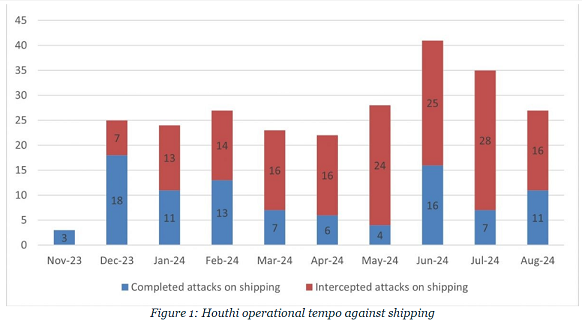
There is something deeply satisfying about seeing a bunch of passionate underdogs square up against the US Military and come away largely unscathed.




